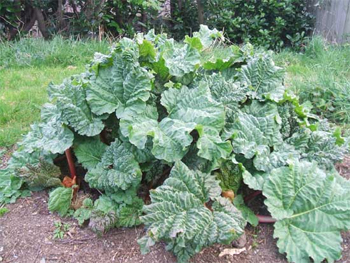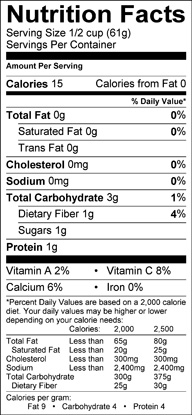Contents:
Common Names | Parts Usually Used | Plant(s) & Culture | Where Found | Medicinal Properties | Biochemical Information
Legends, Myths and Stories | Uses | Formulas or Dosages | How Sold | Warning | Bibliography
Scientific Names

- Rheum palmatum L.
- Polygonaceae
- Buckwheat family
Common Names
- Amla-vetasa (Sanskrit name)
- Chinese rhubarb
- Da-huang (Chinese name)
- Ta-huang (Chinese name)
- Turkey rhubarb
Parts Usually Used
Root
Back to Top
Description of Plant(s) and Culture

This species of rhubarb is a perennial herb which resembles the common garden rhubarb; the conical rootstock, which is fleshy and yellow inside, produces large, cordate, or almost orbicular, 7-lobed leaves on thick petioles that are from 12-18 inches long. A hollow flower stem, 5-10 feet high, also grows from the rootstock and is topped by a leafy panicle of greenish or whitish flowers.
Back to Top
Where Found
Cultivated outside its native Tibet and China mainly for ornamental and medicinal purposes.
Back to Top
Medicinal Properties
Appetizer, alterative, astringent, antipyretic, aperient, purgative, tonic, hemostatic, anthelmintic, vulnerary
Back to Top
Biochemical Information
Flavone, gallic acid, glucogallin, palmidine, pectin, phytosterol, rutin, starch, and tannins, anthroquinones, chrysophanol, physcion, sennidine, rheidine, tetrarin, catechin, pectin, (oxalic acid in the leaves)
Back to Top
Legends, Myths and Stories
Originating from northwest China and Tibet, this herb has been in use for over 2000 years. Gradually it spread through India, reaching Europe during the Renaissance, then into Asia Minor and Turkey. It was a favorite remedy with early Persian and Arabian physicians.
The healthy and hardy pioneer families dared to venture into the unknown wilderness on their drive westward in America. They could take only the necessities of life, such as guns, axes, farm tools, seeds, and other bare essentials on this hazardous journey. Records tell us that among the bare essentials the pioneer women included a piece of rhubarb root to assure themselves and their families of this medicinal treatment. Rhubarb came a long way in 4600 years of history from its native home in western China.
Back to Top
Uses
This is not the garden variety of rhubarb (R. rhabarbarum). The rootstock has a tendency to be both laxative and astringent, depending on the amount used.
Helps disorders of the colon, spleen, and liver. Relieves headache, diarrhea, dysentery, in larger doses for constipation, jaundice, liver problems, skin inflammations,and hemorrhoids. Eliminates worms. Promotes healing of duodenal ulcers. Enhances gallbladder function. Antibiotic properties. In small doses, a cold extract of the rootstock used to stimulate appetite.
Back to Top
Formulas or Dosages
Cold extract: soak the rootstock in cold water for 8-10 hours. For a laxative, take 1 tbsp. 2-3 times a day. For an appetizer, take 1 tsp. 2-3 times a day, shortly before meals.
Rootstock: for a laxative, take 1 tsp. powdered or chopped rootstock in 1/2 cup water. As an astringent for diarrhea, take 1/4 tsp. rootstock in 1/2 cup water. These are doses for one day.
Back to Top
Nutrient Content

How Sold
Available in powdered root or as a tincture
Back to Top
Warning
The leaf blades (although not the stalks) of rhubarb contain enough oxalic acid to cause poisoning. Fatalities have been reported when using the leaves. Prolonged use is not advisable, rhubarb aggravates any tendency toward chronic constipation. Pregnant women and nursing mothers are cautioned against using rhubarb. Also avoid if gout or arthritis is a problem. Use with caution on hemorrhoids.
Back to Top
Bibliography
![]() The Herb Book
The Herb Book, by John Lust, Bantam Books, 666 Fifth Avenue, New York, NY. copyright 1974.
![]() Back to Eden
Back to Eden, by Jethro Kloss; Back to Eden Publishing Co., Loma Linda, CA 92354, Original copyright 1939, revised edition 1994
![]() Chinese Medicinal Herbs
Chinese Medicinal Herbs, compiled by Shih-Chen Li, Georgetown Press, San Francisco, California, 1973.
 Old Ways Rediscovered
Old Ways Rediscovered, by Clarence Meyer, Meyerbooks, publisher, PO Box 427, Glenwood, Illinois 60425, published from 1954, print 1988
![]() Culpeper’s Complete Herbal & English Physician: Updated With 117 Modern Herbs
Culpeper’s Complete Herbal & English Physician: Updated With 117 Modern Herbs, by Nicholas Culpeper, Meyerbooks, publisher, PO Box 427, Glenwood, Illinois 60425, 1990, (reprint of 1814)
![]() Planetary Herbology
Planetary Herbology, by Michael Tierra, C.A., N.D., O.M.D., Lotus Press, PO Box 325, Twin Lakes. WI 53181., Copyright 1988, published 1992
![]() The Complete Medicinal Herbal
The Complete Medicinal Herbal, by Penelope Ody, Dorling Kindersley, Inc, 232 Madison Avenue, New York, NY 10016, First American Edition, copyright 1993
![]() Indian Herbalogy of North America
Indian Herbalogy of North America, by Alma R. Hutchens, Shambala Publications, Inc., Horticultural Hall, 300 Massachusetts Avenue, Boston, Massachusetts 02115, 1973
![]() American Folk Medicine
American Folk Medicine, by Clarence Meyer, Meyerbooks, publisher, PO Box 427, Glenwood, Illinois 60425, 1973
![]() The Yoga of Herbs: An Ayurvedic Guide to Herbal Medicine
The Yoga of Herbs: An Ayurvedic Guide to Herbal Medicine, by Dr. David Frawley & Dr. Vasant Lad, Lotus Press, Twin Lakes, Wisconsin, Second edition, 1988.
![]() Prescription for Nutritional Healing, Fifth Edition: A Practical A-to-Z Reference to Drug-Free Remedies Using Vitamins, Minerals, Herbs & Food Supplements
Prescription for Nutritional Healing, Fifth Edition: A Practical A-to-Z Reference to Drug-Free Remedies Using Vitamins, Minerals, Herbs & Food Supplements, by James F. Balch, M.D. and Phyllis A. Balch, C.N.C., Avery Publishing Group, Inc., Garden City Park, NY
![]() Webster’s New World Dictionary
Webster’s New World Dictionary, Third College Edition, Victoria Neufeldt, Editor in Chief, New World Dictionaries: A Division of Simon & Schuster, Inc., 15 Columbus Circle, New York, NY 10023
 The Rodale Herb Book: How to Use, Grow, and Buy Nature’s Miracle Plants (An Organic gardening and farming book)
The Rodale Herb Book: How to Use, Grow, and Buy Nature’s Miracle Plants (An Organic gardening and farming book), edited by William H. Hylton, Rodale Press, Inc. Emmaus, PA, 18049., 1974
